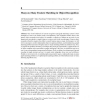DAGSTUHL
2006
14 years 28 days ago
2006
A successful detection and classification system must have two properties: it should be general enough to compensate for intra-class variability and it should be specific enough to...
DAGSTUHL
2006
14 years 28 days ago
2006
Three distinct and interacting types of entities: people, software agents and e-markets are considered in this paper. These entities operate within Shaman, a proposed framework fo...
DAGSTUHL
2006
14 years 28 days ago
2006
DAGSTUHL
2006
14 years 28 days ago
2006
In this chapter, we aim to connect the areas of object categorization and figure-ground segmentation. We present a novel method for the categorization of unfamiliar objects in diff...
DAGSTUHL
2006
14 years 28 days ago
2006
Cognitive Vision has to represent, reason and learn about objects in its environment it has to manipulate and react to. There are deformable objects like humans which cannot be des...
DAGSTUHL
2006
14 years 28 days ago
2006
Cognitive vision is an area that is not yet well-defined, in the sense that one can unambiguously state what issues fall under its purview and what considerations do not. Neither i...
DAGSTUHL
2006
14 years 28 days ago
2006
One of the bottlenecks of current recognition (and graph matching) systems is their assumption of one-to-one feature (node) correspondence. This assumption breaks down in the gener...
DAGSTUHL
2006
14 years 28 days ago
2006
DAGSTUHL
2006
14 years 28 days ago
2006
We examine the possible use of Description Logics as a knowledge representation and reasoning system for high-level scene interpretation. It is shown that aggregates composed of m...
DAGSTUHL
2006
14 years 28 days ago
2006
This paper presents novel language and analysis techniques that significantly speed up software model checking of data structure properties. Consider checking a red-black tree imp...

